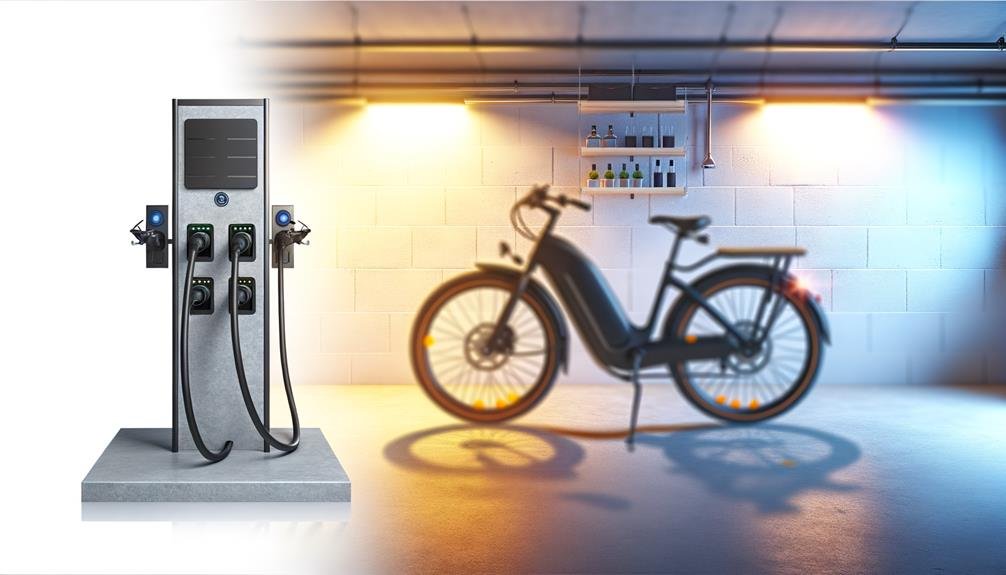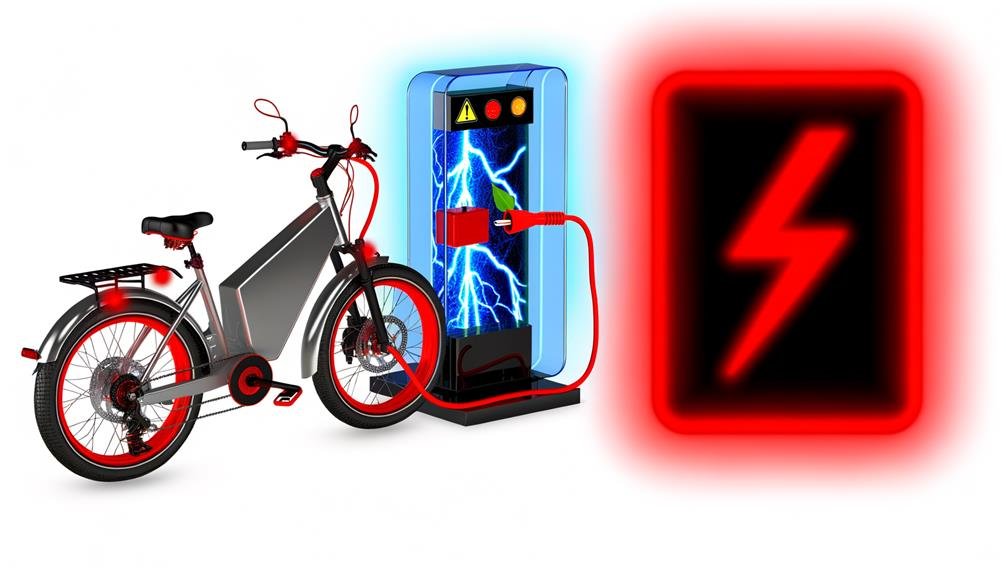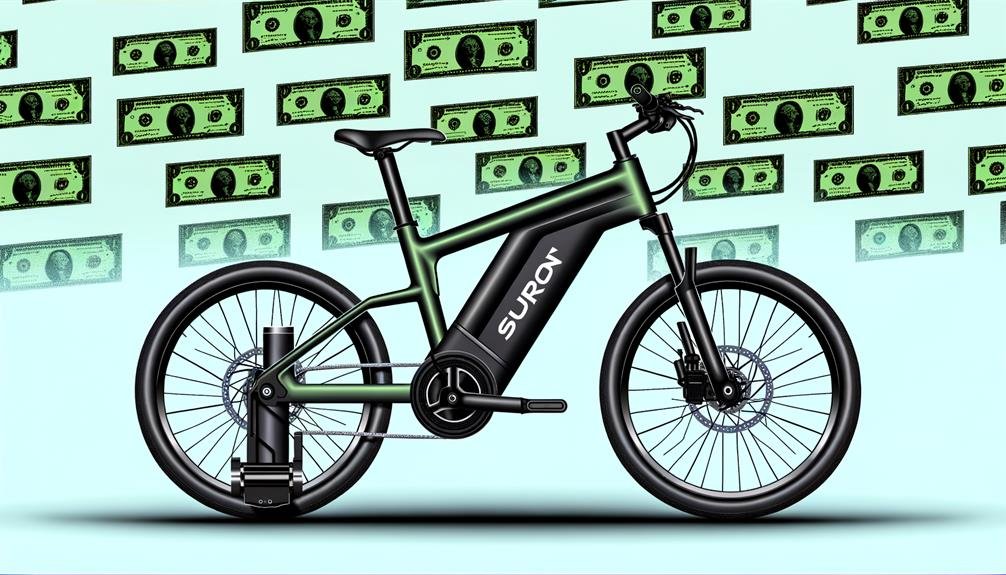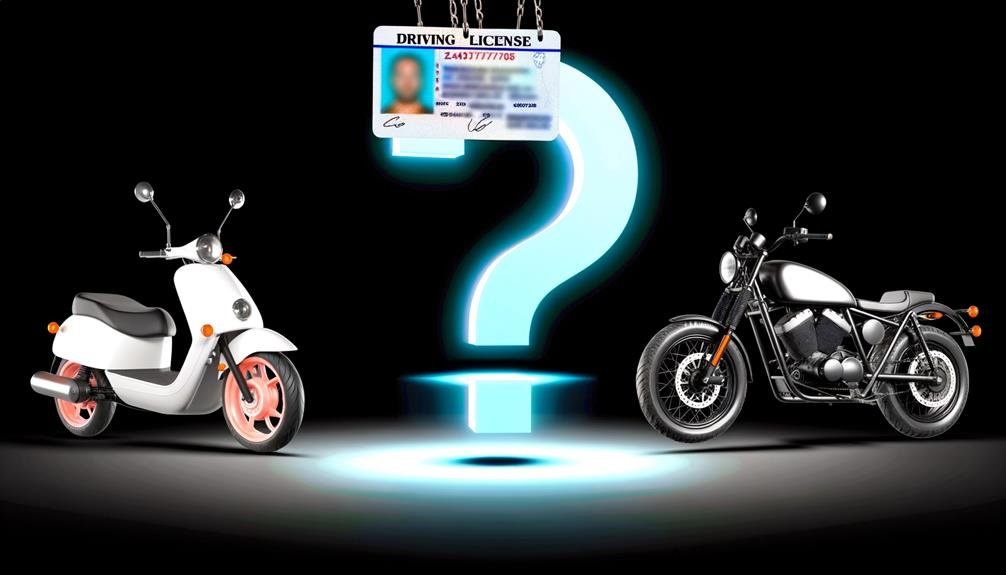Charles Miller is a veteran bike enthusiast with over 12 years of experience dealing with bikes as a mechanic. Despite immense love and expertise for...
Have you ever wondered how an electric bike charges?
As a user of electric bikes myself, I've found the charging process to be quite fascinating.
Like any other rechargeable device, electric bikes primarily rely on being plugged into a power source.
However, there are other methods of charging too, like through regenerative braking or even pedaling, although these are less common due to their lower return on power.
In the following discussion, we'll explore these methods in detail, reveal how long it typically takes to fully charge an e-bike, and even share some tips on maximizing battery life.
So, let's get charged up and jump in, shall we?
Key Takeaways
- Electric bikes primarily rely on being plugged into a power source for charging.
- Regenerative braking and pedaling to recharge are possible but less efficient compared to plugging the bike in.
- Using a 5A Supercharger reduces charging time and minimizes wear.
- Maintaining a charge level between 20-80% helps preserve the longevity of the battery.
Understanding Electric Bike Batteries
Before we dive into the process of charging an electric bike, it's important to understand how their batteries work. As part of our community, you're not alone in wanting to gain a deeper understanding of electric bike batteries. In fact, it's a common curiosity amongst e-bike enthusiasts.
E-bikes recharge their batteries in a few ways, with the most common one being the traditional plug-in method. But did you know they can also recharge through regenerative braking? This fascinating technology converts the bike's forward motion into battery charge. However, it's not often used due to the low return on power and the extra complexity and weight it adds to the e-bike.
Pedaling to recharge is a possibility, but it's not as efficient as you might think. It typically gives a return of only 10% of the input, making it less practical compared to plugging the bike into the wall.
It's crucial to follow the correct charging procedure to prevent damage to the charger or e-bike battery. This involves turning off the battery before charging, monitoring the charging process, and using a 5A Supercharger. Following these steps can impact the battery lifespan and overall performance of your e-bike.
The Charging Process Explained
So, how exactly does the charging process work for an electric bike? Let's have the charging process explained in a simple yet comprehensive manner.
Firstly, most electric bikes recharge their batteries using a wall charger, much like charging your smartphone. Charging times can vary depending on the battery capacity and the power of the charger.
The bike can also charge using regenerative braking technology. This converts the bike's forward motion into electrical power, topping up the battery as you ride. However, it's important to remember:
Pedaling to recharge the bike is less efficient, yielding only a 10% return on energy input. So, it's not the best way to keep your bike charged up.
Regenerative braking is a bonus feature, not a primary charging method. You'll still need to plug in your bike to fully charge the battery.
E-Bike Charging Equipment

Let's now turn our attention to the actual equipment needed for charging an e-bike.
We'll explore the key components of a charger and discuss how to use them effectively.
This will include tips on best practices for charging to ensure your battery's longevity and optimal performance.
Understanding Charging Components
Diving into the realm of e-bike charging equipment, it's important to note that these bikes can recharge their batteries through a process known as regenerative braking, where energy from forward motion charges the battery. However, understanding charging components of electric bikes is vital for efficient and safe charging.
- Pedaling to recharge has a low 10% return on input, so wall charging is usually preferred.
- Regenerative braking isn't common due to limited power return.
- Correct charging procedure is crucial to prevent any damage.
- Turn off the battery before charging.
- Always charge at room temperature.
- Keep an eye on the process for safety.
Being part of the e-bike community means charging responsibly and efficiently!
Efficient Charging Practices
Having grasped the basics of e-bike charging components, we now turn our attention to efficient charging practices, focusing on the use of suitable e-bike charging equipment. Let's be smart about our ebike batteries and prolong their life.
Here's an easy-to-follow table:
| Practice | Equipment | Benefit |
|---|---|---|
| 1. Use a 5A Supercharger | Battery, Supercharger | Reduces charging time, minimizes wear |
| 2. Proper plugging order | Charger, Battery, Power outlet | Ensures efficient charging |
| 3. Follow manual instructions | Manufacturer's manual | Avoids mishaps, ensures safety |
| 4. Turn off battery before charging | Battery | Protects battery, conserves energy |
| 5. Regular monitoring | Charger, Battery | Prevents overcharging, extends battery life |
Typical Charging Times
Next, let's look at typical charging times for electric bikes.
We'll discuss how understanding battery capacities, the factors that affect charge time, and optimizing your e-bike's charge can help you maximize your riding time.
Getting a handle on these aspects can ensure your e-bike is always ready when you need it.
Understanding Battery Capacities
When it comes to charging electric bikes, it's important to understand that the battery capacity greatly influences the typical charging time. Here's what you need to know about understanding battery capacities:
- Battery capacity is measured in ampere-hours (Ah). A higher Ah means more capacity, which leads to a longer battery life between charges.
- For example, a 10Ah battery might need 3-4 hours to charge, while a 20Ah battery might take 6-8 hours.
- Charging time also depends on the charger's output. A charger with a higher output can charge a battery faster.
- For instance, using a 4A charger instead of a 2A charger could halve the charging time.
Factors Affecting Charge Time
Let's delve into the various factors that can affect the charging time of your electric bike's battery.
The factors affecting charge time are multiple and diverse. Battery capacity and size are crucial; larger batteries naturally take more time to charge.
The type of charger you use also plays a significant role. A standard charger won't match the speed of a 5A Supercharger.
The method you choose for charging is vital too. Whether you charge the battery in the bike or detach it can alter the duration.
Environmental factors, like room temperature, can influence the efficiency of the charging process.
Lastly, the battery's initial charge level can impact the total charging times.
Being aware of these factors ensures a smooth charging experience.
Optimizing Your E-Bike's Charge
While the typical charging times for an electric bike hover around the 4-hour mark, there are several ways to optimize this process and extend your battery's lifespan and performance. You might ask, 'how does an electric bike charge most effectively?' Here's a simple guide on optimizing your e-bike's charge:
- Always switch off the battery before charging.
- Charge only at room temperature.
- Use a 5A Supercharger.
This approach can help you:
- Maximize your battery's longevity.
- Increase its efficiency.
- Save on energy costs.
Maximizing Battery Life
Preserving the longevity of your electric bike's battery requires careful and strategic charging practices. In our quest for maximizing battery life, it's important to remember that the way we charge our e-bikes plays a significant role.
Firstly, it's best to avoid draining the battery completely before recharging it. Frequently doing so can diminish the battery's life over time. It's more advisable to maintain a charge level between 20-80%.
Properly charge your e-bike by using the charger provided by the manufacturer. Off-brand chargers may not have the same safety standards, putting your battery at risk.
Also, be mindful of the temperature when charging. Extreme temperatures, both hot and cold, can harm your battery. Ideally, charge in a cool, dry place.
Lastly, if you're not using your e-bike for an extended period, make sure to store the battery with a partial charge, around 40-60%. Stored batteries lose charge over time, and if they're completely discharged, they could become unusable.
Incorporating these practices into your routine will help in maximizing battery life. After all, we're all in this journey together, aiming for the most efficient and long-lasting e-bike experience.
Signs of Battery Replacement

Recognizing the signs that your e-bike's battery needs replacement is crucial to maintain optimal performance and range. We're all in this together, so let me share some telltale signs of battery replacement that you should be on the lookout for.
- Capacity loss: If you notice your battery's capacity diminishes over time, it could be a sign that it's time for a replacement.
- Decreased Range: Has your bike's range dropped to 70% or less of its original capacity? That's a strong indication that you should consider battery replacement.
- Battery Age: Even if your battery is less than two years old, it might still require replacement. Warranty claims could be your saving grace here.
Safety Tips During Charging
Now that we've identified the signs of needing a battery replacement, let's shift our focus to some crucial safety tips during the charging process. We're all in this together, so it's essential that we look out for each other and share best practices when charging our electric bikes.
Before we delve into the details, here's a quick table for easy reference:
| Safety Tips During Charging | Why it's Important | How to Do it |
|---|---|---|
| Follow the correct charging procedure | Prevents damage to the charger or battery | Consult the manufacturer's manual |
| Be cautious when plugging the charger | Prevents spark and power surge | Plug in the charger as per the instructions |
| Turn off the power before connecting or disconnecting the charger | Prevents accidental power surge | Always switch off the power first |
| Follow specific instructions for plugging and unplugging | Ensures safety and longevity of the battery | Follow the manufacturer's guidelines |
Frequently Asked Questions
Do Electric Bikes Charge While Pedaling?
Yes, electric bikes can charge while pedaling, but it's not very efficient. You'd only get a 10% return, so pedaling 10km would only give you 1km of charge. It's better to charge from a wall outlet.
How Long Does It Take to Charge an Electric Bike at the Station?
Typically, I charge my electric bike at the station for around 4 hours. It's as simple as plugging in a phone, but instead of a chat marathon, I'm fueling up for a biking adventure.
Can Electric Bike Be Charged at Home?
Absolutely! I charge my electric bike at home all the time. It's as simple as plugging it into a normal wall outlet. Typically, it takes around four hours to fully charge. Just remember to monitor it safely.
How Far Will an Electric Bike Go on a Charge?
I'm glad you asked! An electric bike's range depends on the battery capacity. On average, you'll get about 20-50 miles on a single charge. It's quite an efficient way to commute, isn't it?
Conclusion
Just like a hardworking farmer reaps his harvest after a day's work, my e-bike's battery flourishes with power after being plugged in.
It's not as fruitful when I pedal to charge, a bit like expecting a full crop from a few scattered seeds. But hey, that's the beauty of technology, right?
We plug, we charge, we ride, and we keep the cycle going, as smoothly as the seasons turn.
And that's the simple art of charging an electric bike.

Charles Miller is a veteran bike enthusiast with over 12 years of experience dealing with bikes as a mechanic. Despite immense love and expertise for his Tacoma, he rides his Trek Ebike more. Anytime you meet him, you’ll either hear him talking about Bikes, or writing about all things bikes and cars on this blog.
More Posts


